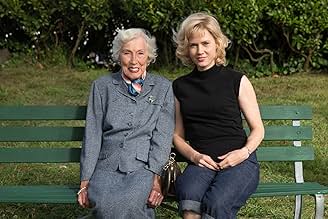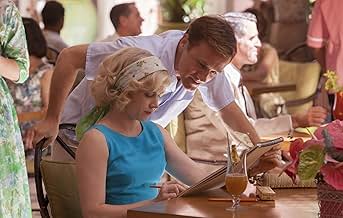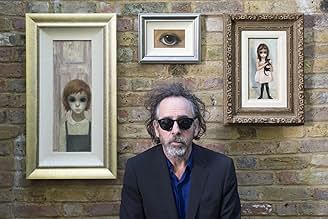Ein Drama über die Anfänge der Malerin Margaret Keane, ihren phänomenalen Erfolg in der 50er Jahren sowie die folgenden gerichtlichen Auseinandersetzungen mit ihrem Ehemann, der in den 60er ... Alles lesenEin Drama über die Anfänge der Malerin Margaret Keane, ihren phänomenalen Erfolg in der 50er Jahren sowie die folgenden gerichtlichen Auseinandersetzungen mit ihrem Ehemann, der in den 60er Jahren ihre Arbeiten für sich beanspruchte.Ein Drama über die Anfänge der Malerin Margaret Keane, ihren phänomenalen Erfolg in der 50er Jahren sowie die folgenden gerichtlichen Auseinandersetzungen mit ihrem Ehemann, der in den 60er Jahren ihre Arbeiten für sich beanspruchte.
- Regie
- Drehbuch
- Hauptbesetzung
- Nominiert für 2 BAFTA Awards
- 3 Gewinne & 18 Nominierungen insgesamt
- 2nd Olivetti Girl
- (as Emily Bruhn)
Empfohlene Bewertungen
This film is a biopic of 1950s novelty pop artist Margaret Keane (formerly Ulbrich, nee Hawkins). She developed a series of haunting acrylic paintings of kids with big dark round eyes. Walter Keane, her rascal salesman of a husband, took advantage of the rising popularity of her paintings. He claimed and mass-marketed them as his own.
Meanwhile, timid Margaret was forced to conform to his web of lies. She was locked in her workroom in their home to paint even more Big Eyes, away from the prying eyes of the public, and even her own daughter. Will Margaret be able to break free from the prison she has trapped herself into?
Amy Adams quietly carried this film capably on her shoulders. There was nothing funny about what she had to do here as Margaret. Her character was the victim of a most cruel crime. Her husband stole not only her art, but also her confidence, and her very freedom. Adams played a weak character, but as an actress, Adams was anything but. With her wise underplaying, Adams successfully won our empathy and compassion for her difficult plight.
Christoph Waltz, on the other hand, was over-the-top, one-dimensional, practically cartoonish, as the manipulative con-man Walter. From his very first scene, you already knew this smooth-talking guy was up to no good. Up to his very last scene in that courtroom, Waltz's Walter was a manic caricature, never really coming across as a real person at all. This may well Tim Burton's direction in play, as this character Walter was the source of most of this film's black humor. Waltz's fiery interaction with Terence Stamp's harsh NY Times art critic character is most memorable as well.
This film's narrative was simple and straightforward. Yet because of Amy Adams' riveting and heart-rending performance, we will be held until the compelling end. The technical aspects of the film, particularly the pastel color palette of the photography, as well as the period production design, costumes and makeup, all contribute to the overall charming look and nostalgic feel of the film as a whole. 7/10.
Amy Adams puts on a really good performance as Margaret. Much like her roles in "Junebug", "Enchanted" and "Doubt", her character's idealism collapses when faced with reality. Christoph Waltz turns Walter into a mixture of smooth and terrifying, but a real creep more than anything.
This is a very different turn for Tim Burton. Far from his homages to horror flicks and swipes at suburban America, he takes a serious approach to the subject matter. I recommend the movie. Whether you know of the story or not, you're sure to be impressed with the movie. Margaret's paintings might not appeal to you - they don't appeal to me - it's important to know what she went through, and the movie does a good job looking at that.
Margaret (Amy Adams) is trying to scrape together a living for herself and her young daughter when she meets Walter Keane (Christoph Waltz), a charismatic real-estate broker who would rather make a name for himself as an artist. He offers her a home, love and financial security, and she quite happily takes his surname as her own. Once they are married, Walter keeps trying to break into the notoriously snobby art world, selling his own Parisian landscapes and Margaret's portraits of wistful young girls with enormous eyes. But it's her art - simply signed as 'Keane' - that grabs the attention and, as one white lie leads to another, Margaret suddenly finds herself shoved into the background. Walter has taken credit for her work, and is well on his way to transforming it into a global phenomenon.
There are many big ideas swirling around in Big Eyes: art, deceit, integrity, commercialism and love are shaken liberally and stirred through with deeper issues of sexism and psychological abuse. This comes through pretty well in the film, which paints a chilling picture of Margaret's enforced anonymity. As her husband delights in dominating newpaper headlines and picking fights with famed art critics like John Canaday (Terence Stamp), she fades almost literally into the background - creating ever more pieces of art for him in the solitude of her attic studio, lying even to her daughter about her life's work. The film also draws a canny, subtle distinction between the artist and the businessman: Walter may not be much of the former, but his skills as the latter are what drag Margaret's work from county fairs onto the international stage.
Through it all, Burton exercises a light - almost impersonal - touch. He scatters a few scenes into the film that hint at his trademark film-making style: Margaret bumps into a crass supermarket display of her art, and suddenly everyone around her sports the limpid, haunting eyes of the waifs no one knows are hers. But, for the most part, Burton keeps himself out of the proceedings. It's proof that he can create nightmares on a more subtle and realistic level, capturing the darker side of life as it can be rather than as he imagines it. Occasionally, however, the film begs the question whether he should - it's stuffy and dry, never quite engaging either the heart or the imagination.
That's through no fault of his cast. Adams anchors Big Eyes with an astounding portrayal of a complex woman: one who's willing to cast off the chains of her first marriage, only to wind up tangled in the snare of another. It would be easy to play Margaret as a victim, but Adams finds the bitter strength in someone who must endure untold torment in a world and home that constantly remind her she's too weak to succeed on her own. Waltz's performance, on the other hand, is puzzling - he plays Walter in the constant key of manic, right from the start, so that the character's smooth, smug charm is all you ever see of the man. There is something undeniably delicious, though, about Waltz's Walter when the cracks begin to show: he simmers his way into a kind of monstrous madness, which lends both drama and humour to the proceedings when Margaret finally brings her claim to court.
On the evidence of Big Eyes, there's hope yet for Burton if he would like to switch to making more literal films. He unearths plenty of smart, insightful tension in this troubled marriage, a partnership on unequal terms that becomes less emotional and more financial by the day. But the film also stumbles along at points, bled dry when it should radiate colour and emotion. It's hard to shake the feeling, too, that Waltz seems to be under the impression that he's in a more old-school, over-the-top Burton production. It's at these moments, in particular, that one might long for a splash of Burton's own personality - the chance to look at this world, this story and these people through his eyes.
The story of Big Eyes is something straight out of the movies, but no, the tale of Margaret Keane and her artistry is based on fact and real life.
Tim Burton's Big Eyes is a dramatic narrative of Margaret Keane, the painter, mother and wife. Having left her husband, with daughter in tow, she seeks a new beginning in California. While there, she hopes to make a living through her art and subsequently meets and marries a man named Walter. Trying to navigate the art world and make a living, her husband claims credit for her artwork which eventually becomes highly profitable. Burton focuses on the awakening of Keane as an artist and to her husband's shortcomings and the legal difficulties in claiming ownership of her work.
Margaret Keane's life is a fascinating and near unbelievable one. And much of Big Eyes' success as a film rests comfortably on that very story. Well, Big Eyes rests on the story of Keane and on Christoph Waltz's immeasurable charm in his performance as Walter Keane.
The sad big eyed children made commercially famous by Keane are uniquely peculiar. Stylistically, it was only right that Tim Burton should direct a film about the painter. It is apparent that Big Eyes is a Burton film; however, Tim Burton subdues his style substantially so that the narrative of this marvelous woman can take center stage. Creatively, this is a refreshing departure for the director.
The Big Eyes movie parallels the artwork of Margaret Keane in an unintentional manner. Margaret Keane was able to look at a person and capture their essence and then put it on canvas with her own twist through large sad eyes. Similarly, Tim Burton takes the core elements of Keane's life and translates it to film with his own fanciful creative liberties. Though everything is in the movie adaptation of Big Eyes, it lacks substance and heart to connect with the audience to have a lasting impression.
Please check out our WEBSITE for all the reviews of recent releases and awards contenders.
Wusstest du schon
- WissenswertesMargaret Keane: Reading a book on a park bench behind Margaret and Walter, when they paint in front of the San Francisco Palace of Fine Arts. The end-credit photo of her sitting with Amy Adams was taken when this scene was filmed.
- Patzer"Tomorrow Forever," the UNICEF painting Margaret Keane painted for the 1964 Worlds Fair, was never actually mounted in the Hall of Education. Robert Moses, who had control over everything that was included in the fair, hated it. Once New York Times critic John Canaday trashed it after seeing a photograph of it, Moses had it thrown into the garbage.
- Zitate
Ruben: What's that with the big crazy eyes?
Walter Keane: Oh. Well, I believe that you can see things in the eyes. The eyes are the window to the soul.
Top-Auswahl
- How long is Big Eyes?Powered by Alexa
Details
- Erscheinungsdatum
- Herkunftsländer
- Offizielle Standorte
- Sprachen
- Auch bekannt als
- Big Eyes - Sie malte es. Er verkaufte es. Und jeder wollte es haben.
- Drehorte
- Produktionsfirmen
- Weitere beteiligte Unternehmen bei IMDbPro anzeigen
Box Office
- Budget
- 10.000.000 $ (geschätzt)
- Bruttoertrag in den USA und Kanada
- 14.482.031 $
- Eröffnungswochenende in den USA und in Kanada
- 3.001.738 $
- 28. Dez. 2014
- Weltweiter Bruttoertrag
- 29.261.617 $
- Laufzeit1 Stunde 46 Minuten
- Farbe
- Sound-Mix
- Seitenverhältnis
- 1.85 : 1
Zu dieser Seite beitragen











































